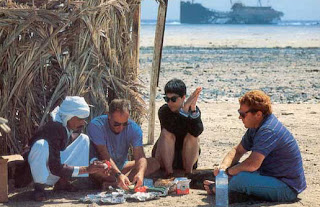Dark-skinned Nubians inhabit the narrow valley south of Aswan. Although modern studies have been unable to establish the ancestry of the Nubian people or trace changes in the race through history, they carry predominantly Caucasian genes and appear unrelated to other Africans. These people once farmed the narrow margins of the river, planting palm groves along its edge. Hoisting triangular lateen sails above their boats, they hauled rock, transported villagers, and fished the clear, cold Nile.
A distinct group for centuries, the Nubians (called Medjy) served the pharaohs as traders and elite military forces. (Middle Kingdom models show them marching in precise rows bearing shields and bows or spears.) During the Late Period, Nubians traveled north, invading Luxor to reestablish classical Pharaonic culture.
For centuries, the Nubians have taken great pride in their unique culture, refusing to intermarry, and in spite of centuries of inbreeding, the population shows little ill effect--weak traits must have been eliminated generations ago. In modern times, their pride has led to valiant attempts to maintain their village life even when nearly all of the men worked and lived hundreds of kilometers to the north. Today, transplanted from the lands inundated by the waters of Lake Nasser, these hard-working people are attempting to revive their culture in the face of economic and social pressures.
Village Life
Originally Nubian villages were closely knit, celebrating births and marriages with village-wide festivals, rituals that always included the river. The newborn child was washed in its life-giving flow, and at circumcision his foreskin was tossed as offering into the river. A bride and groom bathed separately in the fertile waters on the eve of their marriage, then again at dawn, together. After a death, at the end of mourning, the women came to the waters to wash from their faces the mud and blue dye that had been their badge of sorrow, and offer henna and perfume to the spirits of the river. Although the Nubians converted first to Christianity and then to Islam, beliefs in the water angels persist, and the people continue to petition these spirits for favors and blessings.
Dislocations
The Nubian lifestyle suddenly changed when the British built the first Aswan dam in 1902. Its rising forebay drowned their durra plants, choked their date palms, and swallowed their mosques and homes, forcing the people to rebuild their villages higher up the barren slopes. They attempted to cultivate the new banks of the river, but the sandy soil lacked fertile silt and production levels fell. Many of the men left their families to seek work in the towns, traveling as far as Cairo.
The dam was raised three times within 75 years, ultimately sending over 85% of the Nubian men north to find work. The women and children left behind attempted to maintain the village customs, but with husbands and fathers returning only a couple of times a year, traditional rites and festivals were often abandoned. In smaller ways, too, their lifestyle continued to change: tin pots, aluminum pans, and plastic plates replaced woven baskets, for the date palms that had supplied the fronds were now under the lake. The flat roofs, once supported by palm trunks, gave way to vaulted domes, and even dates themselves, a staple of the Nubian diet, had to be imported.
Although some villagers had earlier moved to Aswan, the High Dam forced a final exodus of the Nubians. When 50,000 trekked north, they could at last claim fertile land. Although living in an alien culture, they were no longer solely dependent on wages sent from the cities; families could bring their men home again. Thanks to government programs, the Nubians who have now settled around Aswan and Kom Ombo face a more promising future. Although many Nubian men still work in the cities, the demand for domestic help (jobs Nubians frequently filled) has nearly vanished, and they now can be found running some of the small shops ubiquitous in Egypt, driving cabs, or sailing faluccas. Others have opted for an education, and Nubians with college degrees make up part of Egypt's educated elite.


















